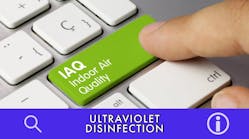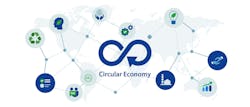ONLINE EXCLUSIVE: Minimize project costs with utility incentives in 2021
It’s an understatement to say that 2020 has been a very unusual year. Utility incentive programs have not skated through unaffected. Given the importance of utility rebates to the LED lighting industry, let’s review how rebate programs have evolved in 2020, and what to expect in 2021.
C&I pandemic impacts
Any look at 2020 has to start with the COVID-19 pandemic and its impacts on C&I (commercial & industrial) rebate programs. The pandemic dampened the new construction and retrofit markets, reducing capital expenditures, and canceling many projects. In response, some utilities added significant bonus incentives to amplify their existing rebate offerings. The bonuses have typically increased the total incentive by 25‒100%, over the standard rebates. Bonuses were offered by C&I prescriptive programs (that provide incentives based on a lamp or luminaire type), as well as calculated/custom programs (that give incentives based on energy saved and/or power reductions). Expect more programs to offer bonuses in 2021.
In addition to bonuses, many C&I utility programs have changed their processes. For example, multiple programs adapted with virtual inspections via Zoom, Skype, or FaceTime walk-throughs. Some also began accepting pre- and post-installation photos rather than an in-person site visit to reduce COVID-19 risks.
Other C&I programs went on hold because of the pandemic. Expect the number of programs on hold to decline in 2021, as more adapt to the pandemic and as the likelihood of vaccine relief increases for Q3 and Q4 2021.
C&I rebate program design
There are many gradual program design shifts occurring in commercial lighting rebate programs. For starters, simple prescriptive programs are being replaced by more complex program models, and with more types of retrofit products in the market, there increasingly is a decision to be made whether to retrofit or replace a fixture. Utility programs are increasingly offering rebates for both, as well as on-bill financing offers. Furthermore, programs are beginning to emphasize the quality and capabilities of the lighting systems are being emphasized. The DesignLights Consortium (DLC) Technical Requirements for the Qualified Products List (QPL) moving from Version 4.4 to V5.0 and V5.1 are the clearest example of this. We’ll cover the DLC in greater detail below.
There’s a growing number of programs that pay the incentive to the distributor, rather than the end user or contractor. Some programs refer to these programs as “midstream,” while others call them “upstream.” Utility program pre-approval time has also been reduced. According to Briteswitch.com, an expert in US rebates and processing service, the average pre-approval time for projects has dropped over the past couple years from 29 days to 18 days, helping to make the process more smooth and efficient for the applicant.
From an application perspective, more programs are incentivizing legal cannabis growing operations to use LED grow lights, efficient HVAC, and intelligent control systems. Sacramento Municipal Utility District (SMUD) in California and Colorado’s Xcel Energy are two examples of such efforts. (See LEDs Magazine’s event preview and coverage of the 2020 HortiCann Light + Tech conference for more details on the increasing opportunities for program collaboration in cannabis grower operations.)
Net-zero energy buildings are another application that is trending up, with the Energy Trust of Oregon implementing such a program, while California has code requirements for net-zero energy homes now and commercial buildings coming soon. Moreover, some programs that are shifting from a model that pays rebates for qualified products to one in which the program administrator pays for energy savings. More utilities are offering strategic energy management programs to promote continuous energy-efficiency improvements.
Changes coming to DLC in 2021
Design Lights Consortium (DLC) is a non-profit that writes product specifications, required by more than 70% of C&I lighting rebate programs. Having DLC-listed products is not a government requirement, but it is often a utility or market requirement for commercial LED products, networked lighting controls, and horticultural LED lighting products. Due to the pandemic, DLC recently announced that it is extending the delisting date for products qualified under SSL Technical Requirements V4.4, by two months. The new dates are:
- Jan. 31, 2021: Deadline to update V4.4 listed products to V5.0 or V51
- Feb. 28, 2021: Delisting date for V4.4 listed products that have not been updated
The change from V4.4 to V5.0 and V5.1 can have a significant impact on the potential rebates a project may receive. V5.0 requires higher efficacy (lumens per watt). Originally, V5.0 was going to require dimmability on standard indoor luminaires and retrofit kits, but this requirement was postponed to the V5.1 requirements. When the DLC delists the v4.4 products on Feb. 28, 2021, most rebate programs will no longer provide incentives for those delisted products. Lighting designers, specifiers, and other stakeholders should make sure LED products in their projects are DLC V5.0 or V5.1 listed, for any rebate projects that will continue into 2021. V5.1 SSL technical requirements will be required in late 2021, with additional specs such as dimming and better light quality.
The final DLC V2.0 Horticultural Technical Requirements are now published on the DLC website, and will go into effect on Mar. 31, 2021. The DLC will begin accepting applications under the V2.0 requirements on this date, and all horticultural lighting applications will continue to be qualified under Technical Requirements V1.2 until Mar. 31, 2021. There is also a first draft of the V2.1 horticultural lighting requirements proposed, which would add the following product types to the current list of eligible horticultural fixtures:
- Lamps
- DC/Power over Ethernet (PoE)/modular products
- Actively-cooled products
While current DLC metrics are focused on photosynthesis, some stakeholders are calling for other important outcome measurements, such as spectral sensitivity of cannabinoids, as an example, to help growers predict product impacts from spectral changes.
Overall, expect commercial lighting rebates to continue in 2021, and some rebates and bonuses will increase next year, as a response to the pandemic. By increasing their lighting incentives, utilities are hoping to increase investments in energy-efficiency projects.
C&I rebate channels
In addition to program design trends, there are also changes occurring in the channels of distribution that utility programs interact with. There are increasing program partnerships with online retailers and distributors. For example, Bulbs.com is an approved distributor in 30 rebate programs, across 22 states, as of mid-2020. Products rebated from online distributors include ENERGY STAR- and DLC-approved TLEDs, reflector lamps, A-lamps, ceiling troffers, high-bay fixtures, mogul base lamps, exterior fixtures, and occupancy sensors. These online rebates can be as much as 90% of qualified product costs.
While manufacturers follow DLC changes closely, distributors have been less aware of changes, in the past, leading to obsolete inventory and scrambling to salvage project rebates, when programs stop accepting products qualified to old DLC requirements.
C&I lighting product rebates
There are a number of trends in how C&I lighting programs are rebating various product categories. There’s a movement toward fixture rebates and away from replacement lamp rebates. There are also increasing rebates available for networked lighting controls (NLCs) and horticultural lights, in large part due to the more recent DLC category additions for these product types.
Roughly 75% of prescriptive rebates for NLCs are per fixture. Typically, the fixture must be DLC listed and receives one level of rebate. Then a rebate adder is provided for each fixture on the NLC system that is DLC listed. Other programs are basing NLC incentives on watts controlled, energy saved, square footage of the project, or project cost percentage.
An annual Cannabis Business Times survey of cannabis cultivators in 2020 found that more than half of cultivators reported using LED technology in propagation, vegetative, and flowering stages (The report can be downloaded as a PDF from https://bit.ly/36v0Yh6). This is double-digit annual growth since 2016. Despite the significant increase in the number of cannabis growers using LED grow lights, only about 37% of growers explored utility rebates in 2020, while 51% explored rebates back in 2018. Of the 37% of respondents that explored rebates this year, 19% submitted and received them. 5% applied but didn’t receive rebates, and 14% are exploring but have not moved forward yet. A majority of participants (62%) said they did not investigate nor apply for these rebates, and 38% indicated they were not aware of grow light rebates.
Residential/retail rebate activity
The COVID-19 pandemic has caused a small increase in residential light bulb purchases, as so many people are spending much more time at home. As such, lighting remains the largest residential energy-efficiency measure, and residential instant rebates at retail locations will continue in 2021. Although incentive levels for all lamp and fixture types are dropping, most programs are continuing to provide rebates on many LED lamps in all of their retail channels.
Certain programs are removing products that have seen huge LED market share gains, including A-lamps, BR lamps, and PAR lamps. Expect increases in program funding for specialty products including fixtures, decorative and vintage-style lamps, health and wellness lighting products (often called human-centric lighting), color-changing lamps, and connected lighting for the home. Additionally, utilities will be focusing more efforts on the hard-to-reach and underserved customer segments, who have been slow to adopt LED-based lighting.
ENERGY STAR’s “Light the Moment” brand will focus on recessed downlight retrofit kits. ENERGY STAR’s “Lighting Moments with Downlights” campaign will promote recessed downlights in partnership with manufacturers and retailers, to bring additional consumer attention to these products.
Conclusion
The Biden Administration in 2021 will likely direct the US Department of Energy to shift from regulatory inaction over the past four years to more aggressive new lighting product regulations. Probable targets are new general service lamp (GSL), specialty lamp, and fluorescent tube lamp (GSFL) regulations to push the market to more quickly complete the transition to LEDs. Over the longer term, additional lighting regulations have the effect of ending utility rebates for these categories of products, as the utilities can no longer claim energy savings for these product replacements.
As LED lighting becomes optimized for more and more applications, utility programs are adapting by incentivizing replacement in more applications, in order to claim the energy savings. Expect rebate programs to become more complex and varied; however, they will remain an extremely important driver for the LED lighting industry.
Get to know our experts
DAVID SHILLER is president of Lighting Solution Development, a consulting firm providing business development, engineering, marketing, and recruiting services to advanced lighting manufacturers. The American Lighting Association awarded Shiller the Pillar of the Industry Award in 2013. Prior to starting his firm, Shiller launched and grew MaxLite’s component sales into a multimillion dollar division. He made significant impacts as product manager for EPA Energy Star’s Lighting Program, including conceiving and commercializing self-ballasted GU24 lamps.
JUAN CARLOS BLACKER is a consultant with a diverse background in energy projects and program coordination. He is currently principal and lead consultant for utility and energy programs at Juan Carlos Blacker Consulting. He also provides account management and subject matter expertise for environmental consulting firm D+R International, and collaborates with Shiller on projects and company accounts in the lighting industry. Blacker has worked on program design, policy development, and market research focused on the needs of the utility and energy sectors.
For up-to-the-minute LED and SSL updates, why not follow us on Twitter? You’ll find curated content and commentary, as well as information on industry events, webcasts, and surveys on our LinkedIn Company Page and our Facebook page.





![The DesignLights Consortium continues to make progress in shifting outdoor lighting products and implementation practices toward a more restrained and thoughtful strategy. [Image does not represent a DLC qualified fixture.] The DesignLights Consortium continues to make progress in shifting outdoor lighting products and implementation practices toward a more restrained and thoughtful strategy. [Image does not represent a DLC qualified fixture.]](https://img.ledsmagazine.com/files/base/ebm/leds/image/2024/08/66be810888ae93f656446f61-dreamstime_m_265700653.png?auto=format,compress&fit=&q=45&h=139&height=139&w=250&width=250)
